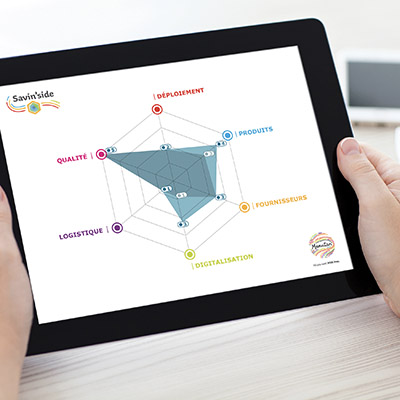The role of Chief Procurement Officers (CPO), also known as lead buyers in some companies, is rapidly evolving. In the age of the digital revolution, the entire procurement profession is being transformed. Chief procurement officers are on the front line, as they pave the way for a new structure, new skills and strategies just to name a few.
Top priorities and strategies for chief procurement officers
- Top priorities
According to "CPO Rising 2018: The Age of Intelligence", the annual survey conducted by Ardent Partners, the current priorities of chief procurement officers are mainly influenced by the technological revolution that is taking place within companies.
For 33% of respondents, the priority is to use advanced analytics, while for 31%, it is a question of identifying new and improved technologies for use in the profession. Saving money is a priority for 31% of respondents and once again can be found in the top three.
These are very closely followed by three other priorities that form the very essence of the profession: the teams (30%), the processes (29%) and the suppliers (28%).
- Top strategies
According to Ardent Partners, chief procurement officers are focusing on different strategies, responding directly to the priorities identified above:
- 47%: improving their use of technologies, either by purchasing new technologies or by improving current ones
- 41%: increasing collaboration within the business
- 34%: strengthening communication with stakeholders
- 28%: implementing more robust policies and processes
- 27%: improving skills across teams
- 23%: improving collaboration with suppliers
New technologies are a key concern for chief procurement officers, followed by the current fundamental principles of the profession such as collaboration and communication.
However, according to Bill Dempsey, Chief Procurement Officer at MolsonCoors, these strategies are likely to change over the next few years: “Trends shaping the business environment continue to evolve and elevate the Procurement function to new levels. The competitive advantage that we can provide has never been more evident. But with this opportunity, we are also challenged to elevate our game. We must cement success in areas such as talent management, category management and customer relationships; and then allow ourselves to evolve to newer strategies such as digitisation and advanced supplier management. I believe that the next three to five years will shape this new agenda for the Procurement profession.”[1]
How to optimise the performance of procurement departments
Procurement departments want to go further, create more value for the company and be more efficient. The professionals surveyed by Ardent Partners identified several factors that could be used to achieve this level of performance:
- 53%: improved visibility over data, accompanied by analytical capabilities
Each year brings the creation of even more data. With the technological revolution, this inevitably leads us towards a data-centric world. The challenge for the profession is therefore to be able to control and use this data in an intelligent manner.
- 42%: get involved with sourcing opportunities at an earlier stage
Procurement teams are often mobilised late on projects, which positions them as project workers rather than project leaders as they should be. The Ardent Partners study stresses that this factor also improves savings, improves quality and reduces risks.
These are followed by two other factors, which appear to be less popular:
- 25%: increase agility in procurement operations
- 21%: better (or more) support from management
It is interesting to compare how chief procurement officers and managing directors do not always see eye-to-eye. Ayming asked respondents working in both roles to highlight the factors that, in their opinion, would allow procurement departments to create additional value:
- Tools and systems are unsurprisingly the primary factor for 76% of managing directors and 90% of chief procurement officers. But are the expectations of procurement professionals too high when it comes to technology?
- Involving the procurement department at an earlier stage in the project is the second factor. Managing directors (70%) and chief procurement officers (68%) seem to agree on this point.
- However, opinions differ when it comes to the 3rd factor. For 66% of chief procurement officers, it is a question of increasing the budget. However, managing directors have a different view of this lever, instead ranking it in 5th place (46%).
- Empowerment/mandate represents the 4th lever for both roles (50% each).
- Once again, the two roles do not agree on this point. For 26% of chief procurement officers, the 5th factor is reorganisation (processes, services etc.), whereas managing directors rank it in 3rd place with 58%.
The areas of improvement are therefore clearly and unanimously identified by chief procurement officers: technologies are the first priority while earlier involvement in projects came in second. These are followed by different strategies that depend on various factors such as increasing agility, reorganising the department and increasing the budget.
Obstacles facing chief procurement officers
Procurement departments often run into various obstacles when improving their performance. According to the survey conducted by SAP Ariba and the University of Applied Sciences Würzburg-Schweinfurt, procurement decision makers list three major obstacles:
- Data Management (the analysis, access and availability of relevant data, in addition to the quality of data) is the main obstacle for 23% of respondents
- Budget restrictions (19%) slow down the digitalisation of procurement
- A lack of in-house talent and knowledge (17%) is a long-term obstacle. It is interesting to note that according to Deloitte, almost ¾ of procurement decision makers claim that their teams have little or no ability when it comes to using current and future technologies.
The Forrester study of procurement decision makers confirms the trend in data management and lists two additional obstacles:
- Time-consuming manual activities (40%) such as converting user requests into orders and invoice and receipt reconciliation
- Computing tools, particularly the insufficient integration of tools (50%), inadequate ERP systems (49%) and not being able to purchase specialist SaaS solutions (45%)
It seems that the obstacles identified by chief procurement officers mostly revolve around digital transformation. This is seen both as a daunting challenge (poor data quality, human resources issues etc.) but also as a powerful factor that could free up procurement officers from low value-added tasks.
From Chief Procurement Officer to Chief Value Officer
The technological revolution is at the heart of the profession's transformation. This is one of the greatest challenges for chief procurement officers today. However, over time it will allow the profession to become more strategic. Their mission will no longer be to make savings (as is already the case for some companies), but to create more value for the company.
Key performance indicators are also changing in this way. Lawrence Kane, Senior Leader of Strategic Sourcing at Boeing, states in an article: “Traditional procurement metrics, such as spend under management, cost savings and the like, are being augmented and occasionally replaced by measures such as supplier innovation, partnering for success and value creation.”
Some professionals then question the job title, asking whether chief procurement officers focusing on creating value rather than solely making savings should in fact be known as "Chief Value Officers"? This would reflect how the "total acquisition cost" has become the total acquisition value.
Chief procurement officers also see the opportunity to break away from the traditional image of a "cost killer" or of a purely tactical and non-strategic role.
Michael Shaw, founder of the Global Council for the Advancement of Women in Procurement has the final word: “Ultimately, the important thing is to be recognised as part of a strategic function, at the C-level, along with the chief information officer and the chief finance officer. I don’t think it is going to happen overnight or across the board. Those who are good at selling the business case will make the change first."
[1] The Deloitte Global Chief Procurement Officer Survey 2018









